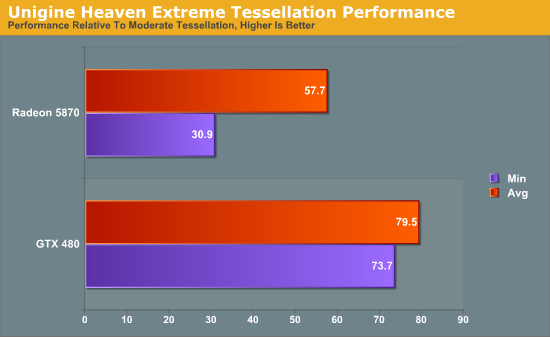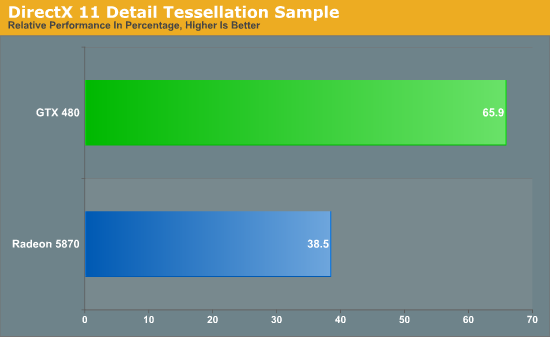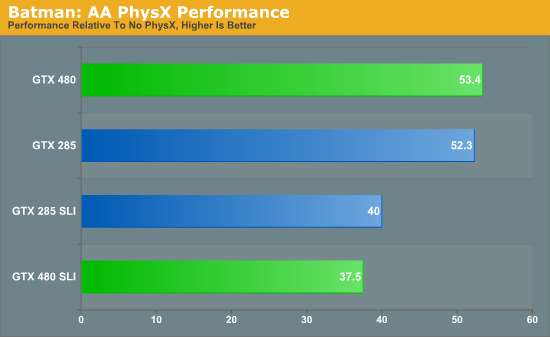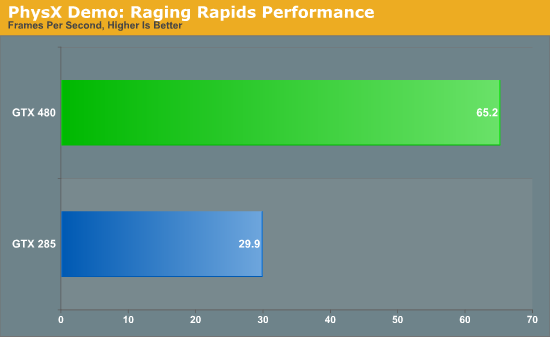NVIDIA’s GeForce GTX 480 and GTX 470: 6 Months Late, Was It Worth the Wait?
by Ryan Smith on March 26, 2010 7:00 PM EST- Posted in
- GPUs
Tessellation & PhysX
We’ll kick off our in-depth look at the performance of the GTX400 series with Tessellation and PhysX. These are two of the biggest features that NVIDIA is pushing with the GTX400 series, with tessellation in particular being the major beneficiary of NVIDIA’s PolyMorph Engine strategy.

As we covered in our GF100 Recap, NVIDIA seeks to separate themselves from AMD in spite of the rigid feature set imposed by DirectX 11. Tessellation is one of the ways they intend to do that, as the DirectX 11 standard leaves them plenty of freedom with respect to tessellation performance. To accomplish this goal, NVIDIA needs significantly better tessellation performance, which has lead to them having 14/15/16 tesselators through having that many PolyMorph Engines. With enough tessellation performance NVIDIA can create an obvious image quality improvement compared to AMD, all the while requiring very little on the part of developers to take advantage of this.
All things considered, NVIDIA’s claim of having superior tessellation performance is one of the easiest claims to buy, but all the same we’ve gone ahead and attempted to confirm it.
Our first tessellation test is the newly released Unigine Heaven 2.0 benchmark, which was released a few days ago. 2.0 added support for multiple levels of tessellation (with 1.0 having earned a reputation of using extreme levels of tessellation), which allows us to look at tessellation performance by varying tessellation levels. If the GTX 480’s tessellation capabilities are several times faster than the Radeon 5870’s as NVIDIA claims, then it should better handle the increased tessellation levels.
Since Heaven is a largely a synthetic benchmark at the moment (the DX11 engine isn’t currently used in any games) we’ll be focusing on the relative performance of cards to themselves in keeping with our editorial policy of avoiding synthetic GPU tests when possible.

Heaven: Moderate & Extreme Tessellation
Heaven has 4 tessellation levels: off, moderate, normal, extreme. For our test we’re using the moderate and extreme modes, comparing the performance of extreme as a percentage of moderate performance.

Starting with averages, the GTX 480 keeps 79% of its performance moving from moderate to extreme. On the Radeon 5870 however, the performance drop-off is much more severe, losing 42% of its performance to bring it down to 58%.
The minimum framerates are even more telling. The GTX 480 minimum framerates drop by 26% when switching to extreme tessellation. The Radeon 5870 is much worse off here, bringing in minimum framerates 69% lower when using extreme tessellation. From these numbers it’s readily apparent that the GTX 480 is much more capable of dealing with very high tessellation levels than the Radeon 5870 is.
Our second tessellation test is similar in nature, this time taken from one of Microsoft’s DX11 sample programs: Detail Tessellation. Detail Tessellation is a simple scene where tessellation plus displacement mapping is used to turn a flat rock texture in to a simulated field of rocks by using tessellation to create the geometry. Here we measure the average framerate at different tessellation factors (7 and 11) and compare the framerate at the higher tessellation factor to the lower tessellation factor.


Looking at just the averages (the framerate is rather solid) we see that the GTX 480 retains 65% of its performance moving from factor 7 to factor 11. The Radeon 5870 on the other hand only retains 38% of its performance. Just as what we saw in Unigine, the GTX 480 takes a much lighter performance hit from higher tessellation factors than the Radeon 5870 does, driving home the point that the GTX 480 has a much more powerful tessellator.
With the results of these tests, there’s no reason to doubt NVIDIA’s claims about GF100’s tessellation abilities. All the data we have points GF100/GTX 480 being much more powerful than the Radeon 5000 series when it comes to tessellation.
But with that said, NVIDIA having a more powerful tessellator doesn’t mean much on its own. Tessellation is wholly dependent on game developers to make use of it and to empower users to adjust the tessellation levels. Currently every DX11 game using tessellation uses a fixed amount of it, so NVIDIA’s extra tessellation abilities are going unused. This doesn’t mean that tessellation will always be used like this, but it means things have to change, and counting on change is a risky thing.
NVIDIA’s superior tessellation abilities will require that developers offer a variable degree of tessellation in order to fully utilize their tessellation hardware, and that means NVIDIA needs to convince developers to do the extra work to implement this. At this point there’s no way for us to tell how things will go: NVIDIA’s superior tessellation abilities could be the next big thing that seperates them from AMD like they’re shooting for, or it could be the next DirectX 10.1 by being held back by weaker hardware. Without some better sense of direction on the future use of tessellation, we can’t make any recommendations based on NVIDIA’s greater tessellation performance.
Moving on we have PhysX, NVIDIA’s in-house physics simulation middleware. After picking up PhysX and its developer AGEIA in 2008, NVIDIA re-implemented PhysX hardware acceleration as a CUDA application, allowing their GPUs to physics simulations in hardware. NVIDIA has been pushing it on developers and consumers alike with limited success, and PhysX only finally had a breakthrough title last year with the critically acclaimed Batman: Arkham Asylum.
With Fermi’s greatly enhanced compute abilities, NVIDIA is now pushing the idea that PhysX performance will be much better on Fermi cards, allowing developers to use additional and more complex physics actions than ever before. In particular, with the ability to use concurrent kernels and the ability to do fast context switching, PhysX should have a reduced degree of overhead on Fermi hardware than it did on GT200/G80 hardware.
To put this idea to the test, we will be using the Batman: Arkham Asylum benchmark to measure PhysX performance. If PhysX has less overhead on Fermi hardware then the framerate hit on the GTX 480 from enabling PhysX effects should be lower than the framerate hit on the GTX 285. For this test we are running at 2560x1600, comparing performance between PhysX being disabled and when it’s set on High.

If PhysX has less overhead on Fermi hardware, Batman is not the game to show it. On both the GTX 480 and the GTX 285, the performance hit on a percentage basis for enabling PhysX is roughly 47%. The GTX 480 may be faster overall, but it takes the same heavy performance hit for enabling PhysX. The SLI cards fare even worse here: the performance hit for enabling PhysX is 60% on both the GTX 480 SLI and the GTX 285 SLI.
PhysX unquestionably has the same amount of overhead on the GTX 480 as it does the GTX 285. If PhysX is going to take up less overhead, then from what we can gather it either will be a benefit limited to PhysX 3, or will require future PhysX 2.x updates that have yet to be delivered.
Or second PhysX test is a more generalized look at PhysX performance. Here we’re using NVIDIA’s Raging Rapids tech demo to measure PhysX performance. Raging Rapids is a water simulation demonstration that uses PhysX to simulate waves, waterfalls, and more. Here we are measuring the framerate in the demo’s benchmark mode.


Overall the Raging Rapids benchmark gives us mixed results. Out of all of the benchmarks we have run on the GTX 480, this is one of the larger performance jumps over the GTX 285. On the other hand, once we compensate for the GTX 480’s additional shaders, we end up with a result only around 10% faster than a strict doubling in performance. This is a sign of good scaling, but it isn’t a sign that the GTX 480 is significantly faster than the GTX 285 due to more efficient use of compute resources. Just having all of this extra compute power is certainly going to make a difference overall, but on an architectural level the GTX 480 doesn’t look to be significantly faster at PhysX than the GTX 285 on a per-clock/per-shader basis.











196 Comments
View All Comments
WiNandLeGeNd - Saturday, March 27, 2010 - link
I think this was a great review, as mentioned previously, very objective. I think though that I may get a 480, because when I buy a card I keep it for 3 to 4 years before I get a new one, aka every other gen. And seeing that tessellation is really the gift horse of DX11 and how much more tessellation power is in the 480's, I think it could very much pay off in the future. If not then I spent an extra $85 for a tad extra performance as I just pre-ordered one for 485 and the 5870's are at $400 still.My only concern is heat and power, but most of the cards have a life time warranty. Hopefully my OCZ GamerXtreme 850W can handle it at max loads. The two 12v rails for the two 6 pin PCI-X connectors are 20 A each, I saw 479w max consumption, however that was furmark, at 12v that's 39.5 amps, so it would be extremely close if there is ever a game to utilize that much power. Although If I recall ATI specifically stated a while back to not use that as it pushes loads that are not possible to see in an actual game, I think they had an issue with the 4000 series burning out power regulators, correct me if I'm wrong.
Alastayr - Saturday, March 27, 2010 - link
I'm with sunburn on this one. Your reasoning doesn't make much sense. You must've not followed the GPU market for the last few years becausefirst) "every other gen" would mean a 2 year cycle
second) Nothing's really gonna pay off in the future, as the future will bring faster cards for a fraction of the price. You'd only enjoy those questionable benefits until Q4, when AMD releases Northern Islands and nVidia pops out GF100b or whatever they'll call it.
third) Tessellation won't improve further that fast. If at all, developers will focus on the lowest common denominator, which would be Cypress. Fermi's extra horse power will most likely stay unused.
fourth) Just look at your power bill. The 25W difference with a "typical" Idle scheme (8h/day; 350d/y) comes to 70kWh which where I live translates to around $20 per year. That's Idle *only*. You're spending way more than just $85 extra on that card.
fifth) The noise will kill you. This isn't a card than just speeds up for no reason. You can't just magically turn down the fan from 60% to 25% and still enjoy Temps of <90°C like on some GTX 260 boards. Turn up your current fan to 100% for a single day. Try living through that. That's probably what you're buying.
In the end everyone has to decide this for himself. But for someone to propose keeping a GTX 480 in his PC for a whopping 3-4 years... I don't know man. I'd rather lose a finger or two. ;)
tl;dr I know, I know. But really people. Those cards aren't hugely competetive, priced too high and nV's drivers suck as much as ATi's (allegedly) do nowadays. Whis is to say neither do.
I could honestly bite me right now. I had a great deal for a 5850 in Nov. and I waited for nV to make their move. Now the same card will cost me $50 more, and I've only wasted time by waiting for the competetive GTX 470 that never was. Argh.
Sunburn74 - Saturday, March 27, 2010 - link
Thats kind of bad logic imo. I'm not fanboy on either side, but it's clear to me that Nvidia targeted the performance of their cards to fit in exactly between the 5970, the 5870, and 5850. Its much harder to release a card not knowing what the other guy truly has as opposed to releasing a card knowing exactly what sort of performance levels you have to hit.Two, realistically, think of the noise. I mean ifyou've ever heard a gtx 260 at 100 percent fan speed, thats the sort of fan noises you're going to be experiencing on a regular basis. Its not a mild difference.
And three, realistically for the premium you're paying for the extra performance (which is not useful right now as there are no games to take advantage of it) as well as for the noise, heat and power, you could simply buy the cheaper 5870, save that 85-150 dollars extra, and sell off the 5870 when the time is right.
I just don't see why anyone would buy this card unless they were specifically taking advantage of some of the compute functions. As a consumer card it is a failure. Power and heat be damned, the noise the noise! Take your current card up to 100 percent fan speed, and listen to it for a few mins, and thats what you should about expect from these gpus.
andyo - Saturday, March 27, 2010 - link
I too am getting the warning message with Firefox 3.6.2. Posting this on IE. Here's the message:http://photos.smugmug.com/photos/820690277_fuLv6-O...">http://photos.smugmug.com/photos/820690277_fuLv6-O...
JarredWalton - Saturday, March 27, 2010 - link
We're working on it. Of course, the "Internet Police" have now flagged our site as malicious because of one bad ad that one of the advertisers put up, and it will probably take a week or more to get them to rescind the "Malware Site" status. Ugh....jeffrey - Saturday, March 27, 2010 - link
Give the advertiser that put up the bad ad hell!LedHed - Saturday, March 27, 2010 - link
The people who are going to buy the GTX 480/470 are enthusiast who most likely bought the GTX 295 or had 200 Series SLI. So not including the 295 in every bench is kind of odd. We need to see how the top end of the last gen does against the new gen top end.Ryan Smith - Saturday, March 27, 2010 - link
What chart is the 295 not in? It should be in every game test.kc77 - Saturday, March 27, 2010 - link
Well the 295 beats the 470 in most benches so there's no need to really include it in all benches. Personally I think the 480 is the better deal. Although I am not buying those cards until a respin/refresh, those temps and power requirements are just ridiculous.bigboxes - Saturday, March 27, 2010 - link
I know you "upgraded" your test PSU to the Antec 1200W PSU, but did you go back and try any of these tests/setups with your previous 850W PSU to see if could handle the power requirements. It seemed that only your 480 SLI setup drew 851W in total system in the Furmark load test. Other than that scenario it looks like your old PSU should handle the power requirements just fine. Any comments?